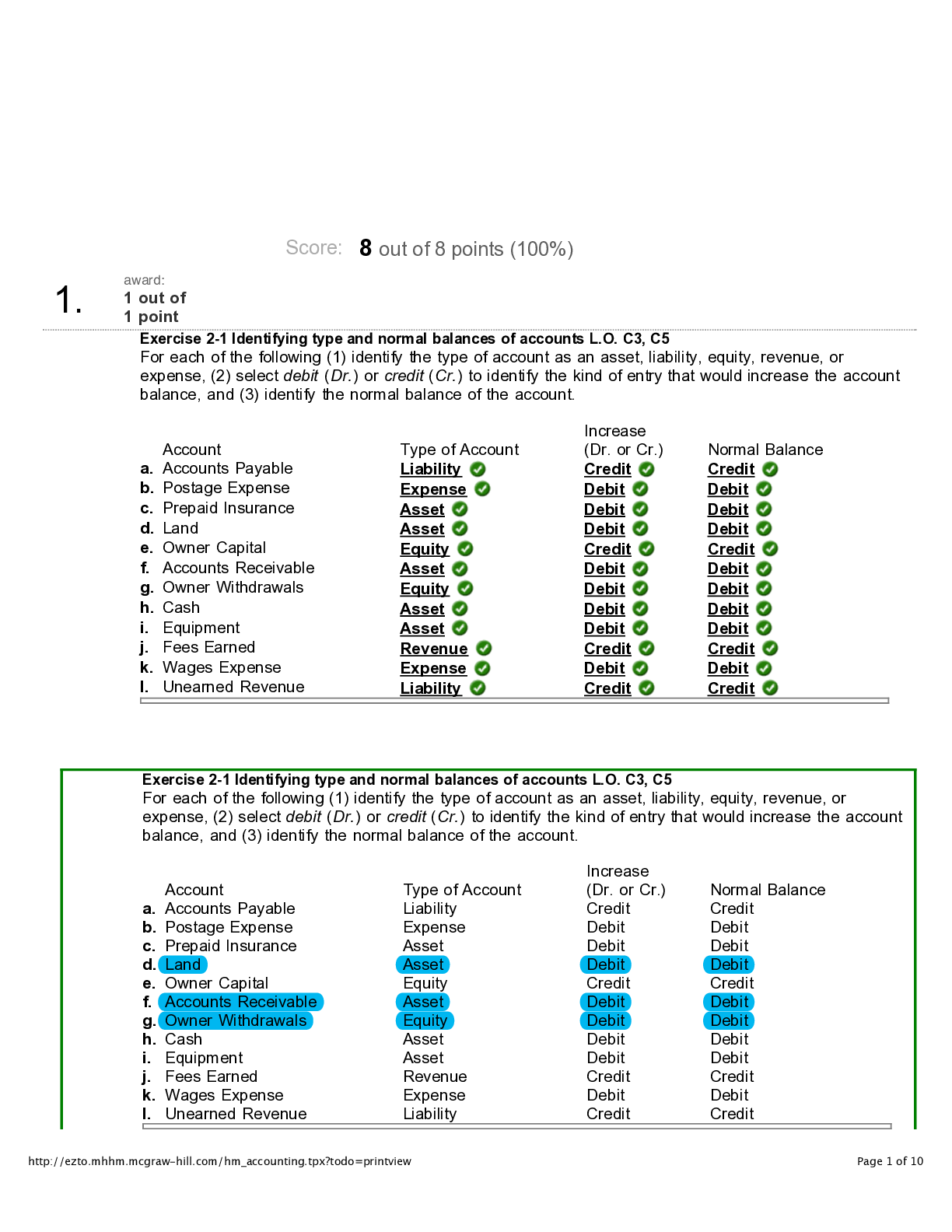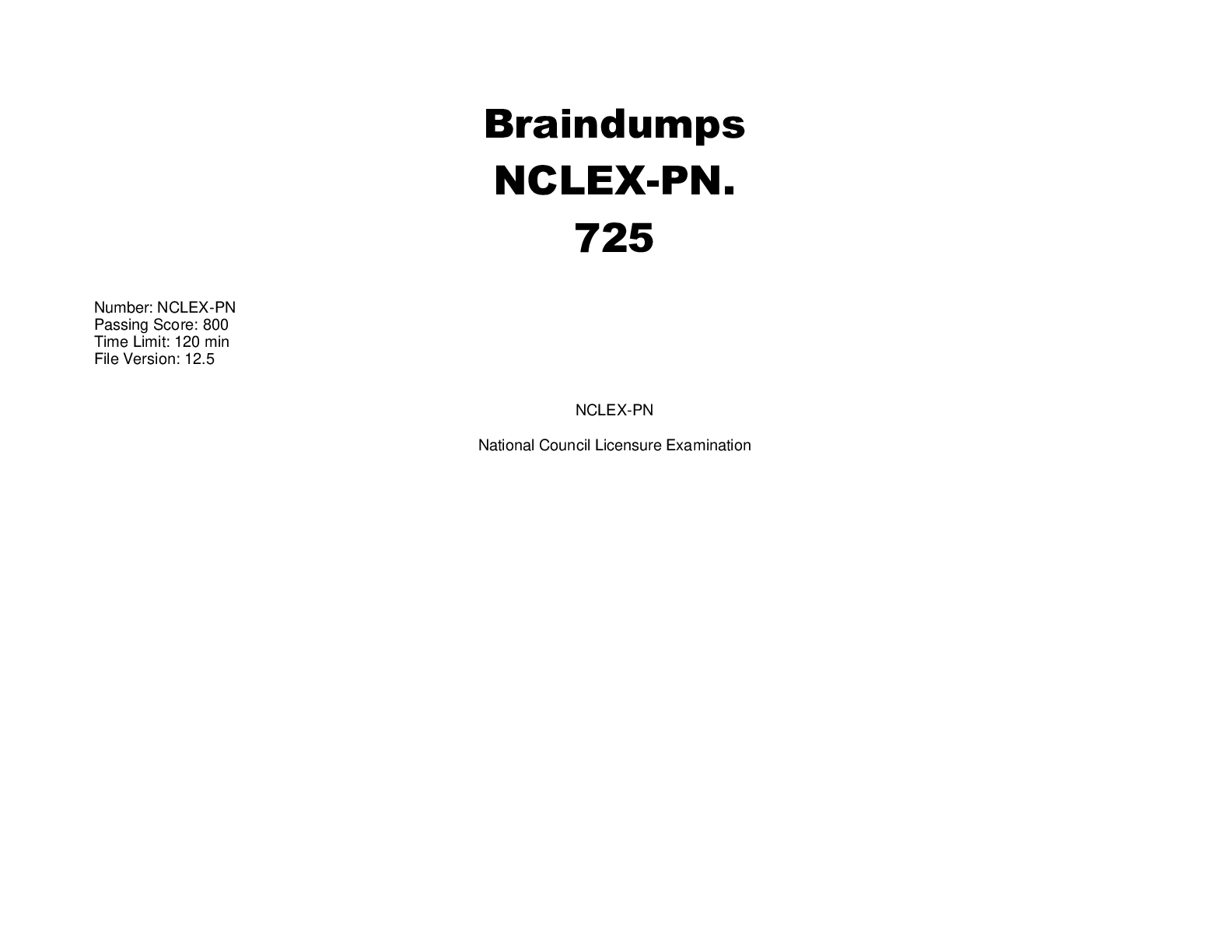*NURSING > QUESTIONS & ANSWERS > Chapter 3: Ethical and Legal Issues. With Answers Explained (All)
Chapter 3: Ethical and Legal Issues. With Answers Explained
Document Content and Description Below
Multiple Choice Identify the choice that best completes the statement or answers the question. ____ 1. In response to a student’s question regarding choosing a psychiatric specialty, a charge nu... rse states, “Mentally ill clients need special care. If I were in that position, I’d want a caring nurse also.” From which ethical framework is the charge nurse operating? 1. Kantianism 2. Christian ethics 3. Ethical egoism 4. Utilitarianism ____ 2. During a hiring interview, which response by a nursing applicant should indicate that the applicant operates from an ethical egoism framework? 1. “I would want to be treated in a caring manner if I were mentally ill.” 2. “This job will pay the bills, and the workload is light enough for me.” 3. “I will be happy caring for the mentally ill. Working in med/surg kills my back.” 4. “It is my duty in life to be a psychiatric nurse. It is the right thing to do.” ____ 3. Without authorization, a nurse administers an extra dose of narcotic tranquilizer to an agitated client. The nurse’s coworker observes this action but does nothing for fear of retaliation. What is the ethical interpretation of the coworker’s lack of involvement? 1. Taking no action is still considered an unethical action by the coworker. 2. Taking no action releases the coworker from ethical responsibility. 3. Taking no action is advised when potential adverse consequences are foreseen. 4. Taking no action is acceptable, because the coworker is only a bystander. ____ 4. Group therapy is strongly encouraged, but not mandatory, in an inpatient psychiatric unit. The unit manager’s policy is that clients can make a choice about whether or not to attend group therapy. Which ethical principle does the unit manager’s policy preserve? 1. Justice 2. Autonomy 3. Veracity 4. Beneficence ____ 5. Which is an example of an intentional tort? 1. A nurse fails to assess a client’s obvious symptoms of neuroleptic malignant syndrome. 2. A nurse physically places an irritating client in four-point restraints. 3. A nurse makes a medication error and does not report the incident. 4. A nurse gives patient information to an unauthorized person. ____ 6. An involuntarily committed client is verbally abusive to the staff, repeatedly threatening to sue. The client records the full names and phone numbers of the staff. Which nursing action is most appropriate to decrease the possibility of a lawsuit? 1. Verbally redirect the client, and then refuse one-on-one interaction. 2. Involve the hospital’s security division as soon as possible. 3. Notify the client that documenting personal staff information is against hospital policy. 4. Continue professional attempts to establish a positive working relationship with the client. ____ 7. Which statement should a nurse identify as correct regarding a client’s right to refuse treatment? 1. Clients can refuse pharmacological but not psychological treatment. 2. Clients can refuse any treatment at any time. 3. Clients can refuse only electroconvulsive therapy (ECT). 4. Professionals can override treatment refusal by an actively suicidal or homicidal client. ____ 8. Which potential client should a nurse identify as a candidate for involuntarily commitment? 1. The client living under a bridge in a cardboard box 2. The client threatening to commit suicide 3. The client who never bathes and wears a wool hat in the summer 4. The client who eats waste out of a garbage can ____ 9. A client diagnosed with schizophrenia refuses to take medication, citing the right of autonomy. Under which circumstance would a nurse have the right to medicate the client against the client’s wishes? 1. A client makes inappropriate sexual innuendos to a staff member. 2. A client constantly demands attention from the nurse by begging, “Help me get better.” 3. A client physically attacks another client after being confronted in group therapy. 4. A client refuses to bathe or perform hygienic activities. ____ 10. A psychiatric nurse working on an inpatient unit receives a call asking if an individual has been a client in the facility. Which nursing response reflects appropriate legal and ethical obligations? 1. The nurse refuses to give any information to the caller, citing rules of confidentiality. 2. The nurse hangs up on the caller. 3. The nurse confirms that the person has been at the facility but adds no additional information. 4. The nurse suggests that the caller speak to the client’s therapist. ____ 11. A client requests information on several medications in order to make an informed choice about management of depression. A nurse should provide this information to facilitate which ethical principle? 1. Autonomy 2. Beneficence 3. Nonmaleficence 4. Justice ____ 12. An inpatient psychiatric physician refuses to treat clients without insurance and prematurely discharges those whose insurance benefits have expired. Which ethical principle should a nurse determine has been violated based on these actions? 1. Autonomy 2. Beneficence 3. Nonmaleficence 4. Justice ____ 13. Which situation reflects violation of the ethical principle of veracity? 1. A nurse discusses with a client another client’s impending discharge. 2. A nurse refuses to give information to a physician who is not responsible for the client’s care. 3. A nurse tricks a client into seclusion by asking the client to carry linen to the seclusion room. 4. A nurse does not treat all of the clients equally, regardless of illness severity. ____ 14. A client who will be receiving ECT must provide informed consent. Which situation should cause a nurse to question the validity of the informed consent? 1. The client is paranoid. 2. The client is 87 years old. 3. The client incorrectly reports his or her spouse’s name, date, and time of day. 4. The client relies on his or her spouse to interpret the information. ____ 15. A client diagnosed with schizophrenia receives fluphenazine decanoate (Prolixin Decanoate) from a home-health nurse. The client refuses medication at one regularly scheduled home visit. Which nursing intervention is ethically appropriate? 1. Allow the client to decline the medication and document the decision. 2. Tell the client that if the medication is refused, hospitalization will occur. 3. Arrange with a relative to add the medication to the client’s morning orange juice. 4. Call for help to hold the client down while the injection is administered. ____ 16. Which situation exemplifies both assault and battery? 1. The nurse becomes angry, calls the client offensive names, and withholds treatment. 2. The nurse threatens to “tie down” the client and then does so, against the client’s wishes. 3. The nurse hides the client’s clothes and medicates the client to prevent elopement. 4. The nurse restrains the client without just cause and communicates this to family. ____ 17. A geriatric client is confused and wandering in and out of every door. Which scenario reflects the least restrictive alternative for this client? 1. The client is placed in seclusion. 2. The client is placed in a geriatric chair with tray. 3. The client is placed in soft Posey restraints. 4. The client is monitored by an ankle bracelet. ____ 18. A brother calls to speak to his sister, who has been admitted to a psychiatric unit. The nurse connects him to the community phone, and the sister is summoned. Later the nurse realizes that the brother was not on the client’s approved call list. What law has the nurse broken? 1. The National Alliance for the Mentally Ill Act 2. The Tarasoff Ruling 3. The Health Insurance Portability and Accountability Act 4. The Good Samaritan Law Multiple Response Identify one or more choices that best complete the statement or answer the question. ____ 19. After disturbing the peace, an aggressive, disoriented, unkempt, homeless individual is escorted to an emergency department. The client threatens suicide. Which of the following criteria would enable a physician to consider involuntary commitment? (Select all that apply.) 1. Being dangerous to others 2. Being homeless 3. Being disruptive to the community 4. Being gravely disabled and unable to meet basic needs 5. Being suicidal Completion Complete each statement. 20. A valid, legally recognized claim or entitlement, encompassing both freedom from government interference or discriminatory treatment and an entitlement to a benefit or a service is defined as a _______________________. 21. A branch of philosophy that addresses methods for determining the rightness or wrongness of one’s actions is defined as _______________________. [Show More]
Last updated: 2 years ago
Preview 1 out of 14 pages

Buy this document to get the full access instantly
Instant Download Access after purchase
Buy NowInstant download
We Accept:

Reviews( 0 )
$6.00
Can't find what you want? Try our AI powered Search
Document information
Connected school, study & course
About the document
Uploaded On
Jan 27, 2020
Number of pages
14
Written in
Additional information
This document has been written for:
Uploaded
Jan 27, 2020
Downloads
0
Views
146



.png)
.png)
.png)
.png)
.png)
.png)
.png)







 Latest Questions and Complete Solutions.png)






